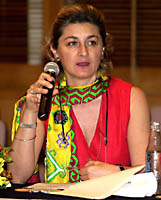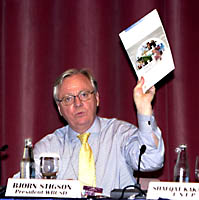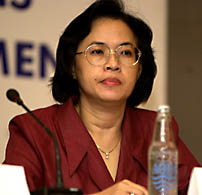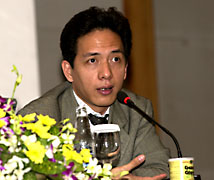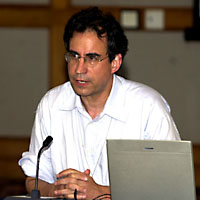|
|
|||||||||||||||||||||||||||||||||||||||||||||||||
|
|||||||||||||||||||||||||||||||||||||||||||||||||
|
Events convened on Tuesday, 28 May 2002 |
|
|
Disaster risk
and sustainable development: Reducing vulnerability to natural hazards
Jasmin Enayati, Stakeholder Forum for Our Common Future, outlined the findings of a recent online conference on disaster risk and sustainable development. The conference found that vulnerability is a result of human action or inaction, and barriers impeding risk prevention include poverty and an inadequate focus on long-term mitigation and community-based disaster preparation. To reduce disaster risk, participants emphasized the need for collective action, improved coordination and sense of responsibility, partnerships with civil society, and information and communication, particularly the use of local knowledge. The conference concluded that mitigation is not just about repairing damage but also building strong foundations for securing a more sustainable future for all at risk. Josephine Shields,
International Federation of Red Cross and Red Crescent Societies (IFRC),
described the IFRC's work on risk reduction at the local level. She said
the IFRC works on community-based disaster preparedness in 80 countries,
building local capacity to reduce the impacts of disaster events and
prepare for those that may occur. The IFRC also engages in mitigation
activities, encourages governments
to strengthen national capacities for disaster response, fosters community
education and organization, and works to ensure that contingency plans are
in place. Other speakers delivered presentations on: regional cooperation and capacity-building efforts by the Asian Disaster Reduction Centre; early warning scope and cooperation at the World Meteorological Organization; and the International Centre for Research on El Niño.
|
|
|
World Business Council for Sustainable Development "Sector Projects" brochure launch Presented by the World Business Council for Sustainable Development (WBCSD)
Nabiel Makarim,
Indonesia, stressed the need for the business sector to: engage in
voluntary initiatives that go beyond government obligations; demonstrate
its commitment to address the most difficult sustainable development
challenges in cooperation with other stakeholders; and make industrial
practices and policies more sustainable. Mostafa Tolba, International Center for Environment and Development, described the history of his engagement with the WBCSD and his participation in assurance groups to guarantee the neutrality and validity of the findings of WBCSD sector projects. He stressed that civil society and the private sector still speak different languages, and recommended that the WBCSD further facilitate involvement of civil society in dialogue on the role of industry in sustainable development.
|
|
|
Wind power for the world Presented by Greenpeace International
Steve Sawyer,
Greenpeace International, presented "Wind Force 12," a joint report by
Greenpeace and the European Wind Energy Association (EWEA), which
represents a blueprint for generation of 12% of the world's electricity
from wind power by the year 2020.
Christian Kjaer,
EWEA, provided an overview of the state of wind energy. He highlighted an
annual rate of growth in wind energy of more than 40%, and outlined
success stories in Denmark, Germany and India. He said cost reductions
have made wind energy competitive with conventional energy sources on good
sites, and underscored the need for power market reform to remove market
distortions that favor fossil fuels and nuclear power.
|
|
|
Inter-linkages - Synergies and coordination among multilateral environmental agreements: National and regional approaches in Asia and the Pacific Presented by the United Nations University (UNU)
This event, chaired by Nirmal Andrews, UNEP Regional Office for Asia Pacific, addressed synergies and coordination among multilateral environmental agreements (MEAs) in the Asia Pacific region. German Velasquez,
UNU, stressed the need to focus on creating synergies between multilateral
environmental agreements (MEAs) at the national and regional levels, as
that is where practical decisions to utilize synergies and coordination
are made, issues are best linked, and country priorities are identified
and related to other development concerns. He highlighted, inter alia,
challenges for the implementation of synergies, including inadequate
capacity, the need to balance centralization and devolution of authority,
a lack of data, and negotiation and implementation gaps. He said regional
and national case studies carried out by UNU could help identify concrete
actions for creating inter-linkages. Uli Piest, UNU, presented the outcomes of a Pacific Island case study on synergies and coordination among MEAs. The study assessed costs and benefits of linkages, focusing on national and regional issues and existing institutional mechanisms. He said the study revealed that: coordination of MEAs requires significant time and resources; ratification of MEAs may require coordination between legal, negotiating and implementing agencies; and the main challenge in implementation is how to translate international obligations into national and local agendas. He recommended, inter alia, the creation of national coordination systems, greater attention to capacity development, and intensified use of regional agreements to leverage global agreements. Raman Letchumanan,
Association of Southeast Asian Nations (ASEAN), presented a case study
that examines how ASEAN countries could address the challenges of creating
synergies through coordinated efforts. He highlighted the role of regional
frameworks and existing institutional mechanisms in implementing MEAs. Discussion: Participants discussed the importance of the ecosystem approach, the lack of capacity to create synergies, weaknesses of existing coordination mechanisms, the importance of clustering MEAs at local and national levels, and examples of initiatives for creating inter-linkages among MEAs in different regions and countries.
|
|
|
Johannesburg + 10: Implementing Agenda 21 after the WSSD Presented by the Natural Resources Defense Council (NRDC)
Jacob Scherr, NRDC, gave an overview of the 1992 Earth Summit in Rio and its outcomes at the international, regional, national and the local levels. He highlighted the entry into force of several conventions, the establishment of National Agenda 21s and environmental action plans in many countries, and increased public awareness and action.
Scherr discussed the
gap in implementation since Rio, and outlined some possible outcomes from
Johannesburg, highlighting Type II initiatives. He addressed the role of
the US in the WSSD process, speculating on the attendance of President
Bush at the Summit.
|
|
|
Collaborative Partnership on Forests: An innovative inter-agency partnership Presented by the United Nations Forum on Forests (UNFF)
Amb. Moeini Meybodi, UNFF Bureau, characterized the CPF as a new invention in inter-agency work at the international level. He said the CPF is a good example of successful and productive collaboration, and expressed the UNFF's optimism about the level of support CPF member organizations can provide for implementation of the UNFF's programme of action. Tiina Vähänen, FAO, provided institutional background on the CPF. She explained that the CPF is not an institution or implementing agency but a voluntary partnership, in which 13 agencies collaborate and coordinate their activities to support the UNFF and foster implementation of its programme of work in member countries. She described the CPF's focal agency system, through which focal agencies address different elements of the UNFF's programme of work and cooperate with other CPF members to mobilize resources and expertise and avoid duplication of work. Representatives of CPF member organizations, including the Secretariats of the Convention on Biological Diversity, the Convention to Combat Desertification, and the UNFF, as well as the GEF, the World Bank, UNDP, and the International Centre for Research in Agroforestry, gave brief presentations on their role in the CPF. Kazuo Asakai, Japan, presented the Asia Forest Partnership (AFP), which the Governments of Japan and Indonesia have agreed to launch as a WSSD Type II outcome. The AFP's purpose is to promote sustainable forest management in Asia, with a focus on forest law enforcement, good governance, illegal logging and rehabilitation and reforestation of degraded lands in ASEAN countries as well as in China, Korea and Japan. He said Japan and Indonesia are seeking to enlist the support, participation and feedback of governments, NGOs and international organizations in the partnership at PrepCom IV, and are convening a meeting in July to further develop it. Jan McAlpine, US, highlighted the value the US Government places on the CPF, and said many frustrated bureaucrats view it as an effective mechanism to enable the necessary shift from words to action. She highlighted an initiative to support sustainable forest management in the Congo Basin, which the US is developing in cooperation with the World Bank, the International Tropical Timber Organization, and other CPF members, and called for input and contributions from interested parties.
|
|
|
|
|
|
|
|
The Earth Negotiations Bulletin (ENB) on the side is a special publication of the International Institute for Sustainable Development (IISD) in cooperation with the United Nations Development Programme (UNDP). The Editor of ENB on the side is Kira Schmidt kira@iisd.org.This issue has been written by Tamilla Held tamilla@iisd.org, Jenny Mandel jenny@iisd.org and Kira Schmidt kira@iisd.org. The Digital Editors are Andrei Henry andrei@iisd.org, Leila Mead leila@iisd.org, and Diego Noguera diego@iisd.org. Funding for publication of ENB on the Side at PC-IV is provided by UNDP. The opinions expressed in ENB on the Side are those of the authors and do not necessarily reflect the views of IISD and funders. Excerpts from ENB on the Side may be used in non-commercial publications only and only with appropriate academic citation. For permission to use this material in commercial publications, contact the Managing Editor at kimo@iisd.org. Electronic versions of issues of ENB on the Side from WSSD PC-IV can be found on the Linkages website at http://enb.iisd.org/2002/pc4/enbots/. |
|
|
| © 2002, IISD. All rights reserved. |
|





